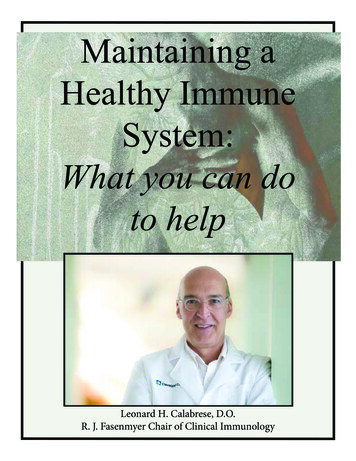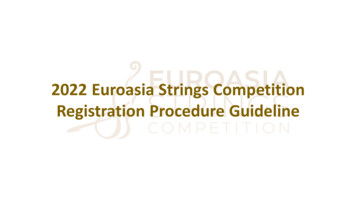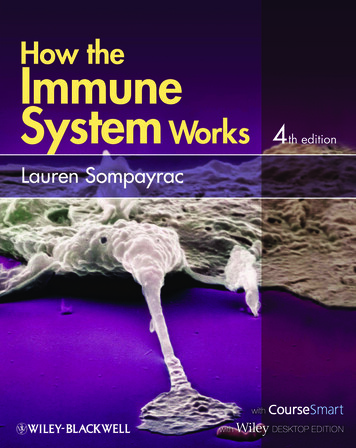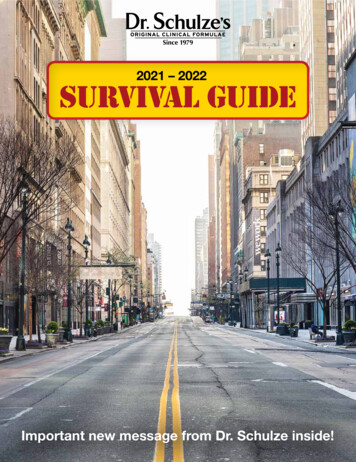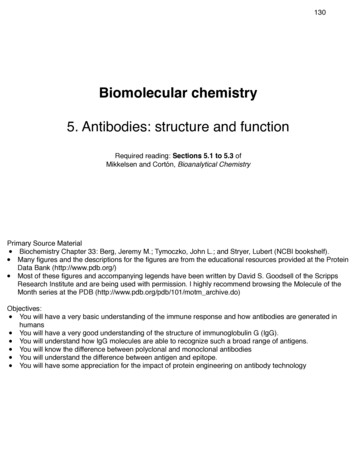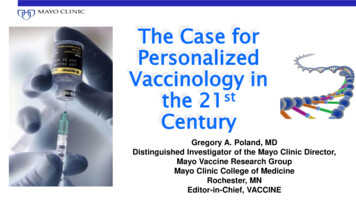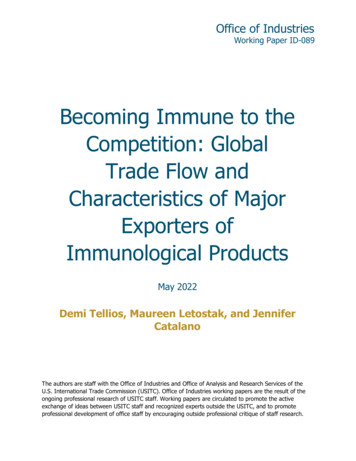
Transcription
Office of IndustriesWorking Paper ID-089Becoming Immune to theCompetition: GlobalTrade Flow andCharacteristics of MajorExporters ofImmunological ProductsMay 2022Demi Tellios, Maureen Letostak, and JenniferCatalanoThe authors are staff with the Office of Industries and Office of Analysis and Research Services of theU.S. International Trade Commission (USITC). Office of Industries working papers are the result of theongoing professional research of USITC staff. Working papers are circulated to promote the activeexchange of ideas between USITC staff and recognized experts outside the USITC, and to promoteprofessional development of office staff by encouraging outside professional critique of staff research.
AbstractImmunological products have emerged as efficacious therapies in several fields, including autoimmunedisease and cancer. The Harmonized Tariff Schedule of the United States defines these products aspeptides and proteins which are directly involved in immunological processes, such as monoclonalantibodies (mAbs), antibody fragments, antibody conjugates, and antibody fragment conjugates.Immunological products had a global export value of 161.1 billion in 2020. The top exporters in theworld by share of total exports were Switzerland (23 percent), Ireland (19 percent), and Germany (15percent). The countries with the top trade balances as net exporters were Ireland ( 27.5 billion),Switzerland ( 25.8 billion), the Netherlands ( 3.9 billion, possible Rotterdam effect), and Germany ( 3.3billion). The focus of this study is on the top global net exporters with the addition of the top global netimporter, the United States. Analysis reveals the top net exporting country characteristics included lowcorporate tax rates on immunological products, investor backing, incentivizing legislation, advantageouspartnerships, and the establishment of specialized manufacturing facilities.2 www.usitc.gov
Becoming Immune to theCompetition: Global Trade Flowand Characteristics of MajorExporters of ImmunologicalProductsDemi Tellios, Maureen Letostak, and JenniferCatalanoOffice of IndustriesU.S. International Trade Commission (USITC)May 2022Demi Tellios was an intern at the U.S. International Trade Commission (USITC) and a student in the master’sdegree program in biotechnology at Georgetown University while working on this paper. Maureen Letostakis a statistician in the Office of Analysis and Research Services at the USITC. Jennifer Catalano is staff withinthe Office of Industries at the USITC. Office of Industries working papers are the result of the ongoingprofessional research of USITC staff. Working papers are circulated to promote the active exchange of ideasbetween USITC staff and recognized experts outside the USITC, and to promote professional developmentof office staff by encouraging outside professional critique of staff research.This paper represents solely the views of the author and is not meant to represent the views of the U.S.International Trade Commission or any of its Commissioners. Please direct all correspondence to JenniferCatalano, Office of Industries, U.S. International Trade Commission, 500 E Street, SW, Washington, DC20436, telephone: 202-205-2056, email: jennifer.catalano@usitc.gov.The authors would like to thank Heidi Colby-Oizumi, Philip Stone, Sarah Oliver, and John Fry for theirassistance with review comments for this report and Byron Barlow for production assistance.United States International Trade Commission 3
Working Paper ID-089IntroductionIn recent decades, the approach to healthcare and patient treatment has been transformed by theinnovation of scientists, researchers, and clinicians alike. Traditionally, physicians have utilized a one-sizefits-all population-based approach to treat their patients. With advances in genomics, big data analytics,and increases in interoperability, there has been a monumental shift toward precision medicine in whichphysicians tailor patient treatments to target the individual. 1 This shift in patient care has manifested itselfin the pharmaceutical industry as well. Big pharma companies have shifted away from the development oftraditional small-molecule entities and have begun to tailor their pipeline mixes to large-molecule biologicsthat target prevalent unmet medical needs. 2Biologics contrast with small molecules in that they are composed of materials derived from living systems- animal, human, and microorganisms and are altered using various cutting-edge biotechnological methods.Biologics also differ in that they are usually administered through injection whereas small molecules aretaken orally. 3 Small molecule chemical structures are simple, well defined, and manufactured throughchemical synthesis which allow for ease of reproducibility. Due to the fact that the majority of biologicsvary in the complexities of their molecular composition, they are instead very often categorized by the wayin which they are manufactured. Biological products include monoclonal antibodies, vaccines, blood, bloodcomponents, recombinant proteins, and gene and cell therapies. 4In 2020, one of the top origins of pharmaceutical pipeline drugs are antibodies as they have an approachtoward more effective targeted therapies. 5 Monoclonal antibodies (mAbs) are used in targetedimmunotherapy treatments for various cancers as well as a wide variety of autoimmune diseases. mAbs areengineered to act as substitute antibodies that can enhance, mimic, or restore the immune system’s attackon perceived foreign or cancerous cells. The top therapeutic category in 2020 was “Anticancer,immunological” which saw an 8.1 percent increase in their pipeline drugs over the previous year. 6This reinforces the growing use of monoclonal antibodies and immunological products in the R&D pipelinefor future biologics. We delve further into the impact that scientific innovation has on the global trademarket of immunological products. We determine the trends in global immunological product trade, thebiggest global players, and reasons for the trends.Halamka, “Precision Medicine,” June 13, 2018.Guatam and Pan, “The Changing Model of Big Pharma,” March 2016. A small-molecule drug is one that has a sizerange of 0.1 to 1 kDa. Large molecules, by extension, are greater than 1 kDa. Theoretically, large molecules could bechemical; however, the term biologic is used to differentiate it from a chemical. Chhabra, Translational Biology, 2021.3Whether a medicine is taken orally or injected will have a fundamental difference in design and may influence cost toproduce it. From a compliance perspective, it is easier for a patient to take a pill at home than to travel to a medicalfacility to receive an injection.4PhRMA, “Biologics,” 2013.5Antibodies were in the top origins for both 2019 and 2020. Informa, “Pharma R&D Annual Review,” 2019, 25;Informa, “Pharma R&D Annual Review,” 2021, table 7, 37-38. Pharmaceuticals includes traditional drugs (e.g., smallmolecule), as well as biologics (e.g., monoclonal antibodies).6The anticancer, immunological group was the top category in both 2019 and 2020. In 2020, monoclonal antibodies ofvarious types were in fourth, twelfth, and fifteenth place for top therapeutic categories. Informa, “Pharma R&DAnnual Review,” 2019, 15; Informa, “Pharma R&D Annual Review,” 2021, 21.124 www.usitc.gov
Becoming Immune to the CompetitionHarmonized Tariff ScheduleImmunological products are currently traded under the following three separate 6-digit subheadings of theHarmonized Tariff Schedule of the United States (HTSUS). 7 These classifications are used withinHarmonized System (HS) as well. 8 3002.13 – Immunological products, unmixed, not put up in measured doses or in forms orpackings for retail sale 3002.14 – Immunological products, mixed, not put up in measured doses or in forms or packingsfor retail sale 3002.15 – Immunological products, put up in measured doses or in forms or packings for retailsaleThe above three breakouts went into effect on January 1, 2017, and they had previously been classified in alarger category that included multiple blood products. 9 The HTS defines immunological products aspeptides and proteins which are directly involved in the regulation of immunological processes, such asmAbs, antibody fragments, antibody conjugates and antibody fragment conjugates. Of note is that amajority of global exports for immunological products for all years studied come from the subheading3002.15, products put up in measured doses or in forms or packings for retail sale. 10Harmonized Tariff Schedule of the United States (2022), Revision 4, USITC Publication 5318, April 2022, Chapter 30.The HTSUS refers to the system of codes within the United States, whereas the HS and its codes is used throughoutthe world. At the first 6-digits, the HTSUS and HS codes are the same. ITA “Understanding HS Codes and the ScheduleB,” accessed April 31, 2022; The World Customs Organization, “What is the Harmonized System?” accessed April 31,2022.9On August 20, 2014, the Commission instituted Investigation 1205—11, pursuant to section 1205 of the OmnibusTrade and Competitiveness Act of 1988 (the Trade Act of 1988) (19 U.S.C.3005), for purposes of recommending to thePresident possible modifications of the HTS (79 FR. 50943, Aug. 26, 2014). One of the modifications underconsideration concerned the World Customs Organization’s (WCO) Recommendation of June 27, 2014 thatContracting Parties to the International Convention on the Harmonized Commodity Description and Coding Systemmodify their tariff schedules to conform with amendments to the Harmonized System (HS). A WCO HS amendmentdeleted HS 3002.10 and added HS 3002.11, 3002.12, 3002.13, 3002.14, 3002.15, and 3002.19. U.S. International TradeCommission, “Recommended Modifications in the Harmonized Tariff Schedule to Conform with Amendments to theHarmonized System Recommended by the World Customs Organization, and to Address Other Matters,” Appendix B,pp. 106-107; Appendix E, pp. 249-250 (Appendix E is the WCO document of Harmonized System amendments).Investigation number 1205—11. USITC Publication 4556. Washington, DC: USITC, July 2015.Subsequent to Investigation 1205—11, the WCO’s HS modifications were implemented into the HTSUS on January 1,2017. Subheading 3002.10.02 was deleted and new subheadings 3002.11.00 through 3002.19.00 were added. The U.S.International Trade Commission, “Modifications to the Harmonized Tariff Schedule of the United States under Section1206 of the Omnibus Trade and Competitiveness Act of 1988 and for Other Purposes,” Items 101-102. USITCPublication 4653. Washington, DC: USITC, December 2016.As the new breakouts in the HTS for immunological products were implemented on January 1, 2017, specific tradedata is only available beginning in January of 2017.10Years 2017-20, IHS Markit, Global Trade Atlas, accessed November 15, 2021.78United States International Trade Commission 5
Working Paper ID-089BiologicsBiologics are known for their treatment in many disease areas. They have revolutionized cancer treatmentoptions, transformed treatment for patients suffering from autoimmune conditions, and have served aseffective first-in-class treatments for patients with conditions that have lacked effective treatment optionsthus far. 11 Patients suffering from chronic, immune-mediated diseases such as rheumatoid arthritis, plaquepsoriasis, multiple sclerosis, ulcerative colitis, and Crohn’s disease have seen remarkable slowing in diseaseprogression as well as symptom management when treated with a biologic. 12 Current biologics on themarket are also being used to treat cancers such as lung, breast, and blood cancers, non-Hodgkin’slymphoma and chronic lymphocytic leukemia. 13Monoclonal Antibody MarketWithin the biologics market, the monoclonal antibody segment has seen a remarkable amount of growthfrom both a scientific development standpoint as well as an economic standpoint. The global market formonoclonal antibodies was valued at roughly 115.2 billion in 2018 and is estimated to continue growing toroughly 300 billion by 2025. 14 These numbers are unsurprising considering that 70 percent of the top tenbest-selling drugs in 2018 consisted of mAbs, with Humira (adalimumab) topping the list with recordbreaking revenues of 19.9 billion. While all of the top ten bestselling monoclonal antibody drugs reachedrevenues of over 3 billion in 2018, it is interesting to note that the majority of them actually reached over 6 billion as well. 15 This can be attributed to the expansion of indications for each molecule. 16 As the yearspass by, pharmaceutical companies preform clinical trials for drugs that they already have on the market inorder to expand upon previous indications for which their products can be used. Expanding uponindications allows the pharmaceutical company to broaden their consumer base while also providingpatients with alternative treatment options. Monoclonal antibodies have seen continual successthroughout the years with the most common medical applications targeting the therapeutic areas ofoncology and immune system disorders.Table 1 lists the top 10 best-selling monoclonal antibody drugs. Five of the top ten mAbs are in theoncology space, including Herceptin (trastuzumab), Avastin (bevacizumab), Keytruda (pembrolizumab),Opdivo (nivolumab), and Rituxan (rituximab). Of these, Roche’s Herceptin targets human epidermalgrowth factor receptor 2 (HER2) in breast cancer while Avastin targets vascular endothelial growthfactor for the treatment of a variety of cancers. Both of these have shown tremendous sustainedcommercial success throughout the years. More recently Merck & Co’s Keytruda and Bristol-MyersSquibb’s Opdivo have entered the mAb oncology market as immune checkpoint inhibitors with adifferent mechanism of action that inhibits programmed cell death protein 1 (PD-1) receptors. 17 Threeof the top 10 best-selling mAbs in 2018 are in the immunology space. AbbVie’s Humira and Johnson &Ogbru, “Biologics,” October 28, 2019.Feldman, Bagel, and Namak, “Biosimilars for Immune-Mediated Chronic Diseases in Primary Care,” May 2018.13Stone, “Top 10 Biologics Drugs in the United States,” May 18, 2021.14Lu et al., “Development of Therapeutic Antibodies for the Treatment of Diseases,” January 2, 2020.15Refer to Table 1 of this paper.16The term indication refers to a condition which makes a particular treatment or procedure advisable. MedicineNet,“Medical Definition of Indication,” reviewed March 29, 2021.17Biopharma Dealmakers, “Moving Up with the Monoclonals,” September 19, 2019.11126 www.usitc.gov
Becoming Immune to the CompetitionJohnson’s Remicade target and block tumor necrosis factors (TNFs). Using this mechanism of action,both Humira and Remicade have expanded indications treating numerous immune diseases includingCrohn’s, psoriasis, and rheumatoid arthritis. Finally, Johnson & Johnson’s Stelara treats the samediseases as Humira and Remicade but with a different mechanism of action, instead targetinginterleukins IL-12 and IL-23. 18Table 1 Top 10 best selling monoclonal antibody drugs in 2018, in billion US 2018Revenue 19.9 bnDrug (mAb)Humira (Adalimumab)Indications *Rheumatoid arthritis; Psoriasis; Crohn's diseaseCompanyAbbVieOpdivo (Nivolumab)Melanoma; Non-small cell lung cancer;LymphomaMelanoma; Head and neck cancer; LymphomaBristol-Myers Squibb 7.6 bnMerck & Co 7.2 bnBreast cancer; Gastric cancerRoche/Genentech 7.0 bnColorectal cancer; Breast ERB2 negative cancer;GlioblastomaNon-Hodgkin's lymphoma; Chronic lymphocyticleukemia; Rheumatoid arthritisCrohn's Disease; Rheumatoid arthritis; UlcerativecolitisPsoriasis; Psoriatic arthritis; Crohn's DiseaseRoche/Genentech 6.8 bnRoche/Genentech 6.8 bnJohnson & Johnson 5.9 bnJohnson & Johnson 5.2 bnParoxysmal nocturnal hemoglobinuria; Atypicalhemolytic uremic syndromeAsthma; Chromic idiopathic urticariaAlexion 3.6 bnRoche/Genentech 3.0 stin (Bevacizumab)Rituxan (Rituximab)Remicade (Infliximab)Stelara (Ustekinumab)Soliris (Eculizumab)Xolair (Omalizumab)Source: Lu et al., “Development of Therapeutic Antibodies for the Treatment of Diseases,” January 2, 2020, table 2.*Not all indications for each drug listed. Sales were reported by biologics or pharmaceutical companies.Even in such a successful area of biopharmaceuticals, innovation is still thriving, in 2019 there were roughly570 antibody therapeutics in various phases of development globally, with 79 of those novel antibodiescurrently in late-stage clinical trials. 19 The monoclonal antibody space is currently dominated by thefollowing seven biopharmaceutical companies: Genentech (a member of the Roche group), AbbVie,Johnson & Johnson, Bristol-Myers Squibb, Merck Sharpe & Dohme, Novartis, and Amgen. 20In comparison to other classes of drugs, 9 monoclonal antibodies are ranked among the top 20 drugs bysales value worldwide (table 2). 21 The top 2 spots by sales are antibodies, including the world’s bestsellingdrug, Humira. In 2012, Humira became the top-selling drug globally and has remained in first place as of2020. 22Biopharma Dealmakers, “Moving Up with the Monoclonals,” September 19, 2019.Kaplon and Reichert, “Antibodies to Watch in 2019,” Feb-March 2019; Kaplon et al., “Antibodies to Watch in 2020,”Jan-Dec 2020.20Lu et al., “Development of Therapeutic Antibodies for the Treatment of Diseases,” January 2, 2020.21Antibodies hold rank number 1, 2, 7, 8, 11, 14, 16, 17, and 20.22Sagonowsky, “Top 20 Drugs,” May 3, 2021.1819United States International Trade Commission 7
Working Paper ID-089Table 2 Top 20 drugs by global sales, 2020, antibody therapies shown in bolded blue, in billion US yAbbVie2KeytrudaPembrolizumabMerck & Ibrutinib6EyleaAfliberceptRegeneron / EtanerceptAmgen12Prevenar 1313IbrancePneumococcal 13- Pfizervalent inib8 www.usitc.govTherapy Area/ Drug ClassRheumatic diseases/TNF alfainhibitorsCancer chemotherapy/AntiPD-1 monoclonal antibodiesBristol Myers Squibb ticoagulant for HeartArrhythmias/Factor XainhibitorsAbbvie / J&JLeukemia and Lymphoma /BTK inhibitorsJ&J/Bayer2020WorldwideDrug Sales(US billion)20.414.412.29.28.43Wet Macular Degeneration /Anti-angiogenic ophthalmicagentsImmunosuppressant/Interleukin inhibitors8.4Cancer Chemotherapy/AntiPD-1 monoclonal antibodiesHIV /Antiviral combinations7.9Anticoagulant / Factor XainhibitorsAntirheumatics/ TNF alfainhibitorsPneumococcal vaccine6.9Breast Cancer;Chemotherapy/CDK 4/6inhibitorsRocheCancer Chemotherapy/VEGF/VEGFR inhibitorsEli LillyDiabetes / Incretin mimeticsRocheMultiple Sclerosis / CD20monoclonal antibodiesRoche/Pharmstanda Rheumatic Diseases, CancerrdChemotherapy/Antirheumatics, CD20 monoclonal antibodiesAstellas Pharma,Prostate cancer /PfizerantiandrogensAstra ZenecaNon-Small Cell Lung Cancer /EGFR 33
Becoming Immune to the ceuticalCompanyJ&JTherapy Area/ Drug ClassRheumatic Diseases/antirheumatics2020WorldwideDrug Sales(US billion)4.195Source: PharmaDigiCoach, “Biggest Blockbuster Drugs of 2020,” September 19, 2021; Sagonowsky, “Top 20 Drugs,” May 3, 2021.BiosimilarsIn the biotechnology and biopharmaceutical space, obtaining intellectual property rights to a drug product,its formulation, or manufacturing process is critical to gaining market exclusivity and in turn marketsuccess. According to U.S. patent law, a utility patent is viable for 20 years from the earliest filing datesubmitted to the U.S. Patent and Trademark Office (this excludes provisional applications). As some of themost well-known biologics begin to lose patent protection, there has been a remarkable influx ofcompetitors in the market trying to create medically equivalent treatments, known as biosimilarequivalents or biosimilars. According to the FDA, a biosimilar is designed to be “highly similar” to an alreadyFDA-approved reference product with no clinically meaningful differences in purity, molecular structure,and bioactivity. 23The exact chemical composition of small molecules is very well known and in turn allows for ease inreproducibility when creating an identical generic once a drug reaches patent expiry. Unlike smallmolecules, the complex molecular structure of biologics makes them costly to develop, produce, andmanufacture. This expense is incurred by physicians, patients, payers, and the healthcare system as awhole. In order to help reduce costs and stimulate competition in biologics manufacturing, the U.S.Congress passed legislation that created the BPCIA (Biologics Price Competition and Innovation Act) in2009. 24 This act encourages companies to develop biosimilars through an abbreviated and cost-effectiveFood and Drug Administration (FDA) approval pathway. It should be noted that in 2005, the EuropeanUnion established a similar regulatory pathway for biosimilar approval through its regulatory body, theEuropean Medicines Agency (EMA). The emergence of biosimilars provides greater patient access to costeffective medical equivalents to biologics. Even with legislative efforts being made toward the developmentof biosimilars, they are still very difficult to develop because they require a great deal of reverseengineering of the original molecule in order to understand its physiochemical and biologicalcharacteristics.The global market for biosimilars was worth roughly 11.8 billion in 2020 and is projected to grow by 35.7percent in 2025. 25 Examples of biosimilars are depicted in table 3. The increased growth in the biosimilarsmarket is connected to increases in demand for affordable alternatives to biologics as well as the increasedincidence of chronic diseases. It can be noted that within the biosimilars market, the monoclonal antibodies(mAbs) segment is the largest. 26 This trend is driven by the imminent patent expiration of some of the most23FDA, “What is a Biosimilar?” accessed May 31, 2021; FDA, “Implementation of the Biologics Price Competition andInnovation Act of 2009,” February 12, 2016.24Boehringer Ingelheim, “What is the Promise of Biologic Medicines?” 2019. FDA, “Implementation of the BiologicsPrice Competition and Innovation Act of 2009,” February 12, 2016.25MarketsandMarkets, “Biosimilars Market,” March 2020.26MarketsandMarkets, “Biosimilars Market,” March 2020.United States International Trade Commission 9
Working Paper ID-089notable blockbuster mAb biologics including but not limited to Remicade (infliximab), Humira(adalimumab), Herceptin (trastuzumab), Avastin (bevacizumab), and Rituxan (rituximab).27Table 3 Selected monoclonal antibody biologics for which biosimilars are being inBevacizumabRituxanRituximabBiosimilar Late-stageManufacturersOriginatorEU PatentU.S. Patent ExpirationExpiration * *Merck/Samsung Bioepis,Celltrion/Pfizer (Hospira)Amgen, Sandoz, BoehringerIngelheimJohnson &JohnsonAbbVie2018201520162018Pfizer, Amgen/Allergan/Synthon,Mylan/Biocon, Cellitron/TevaAmgen, Outlook enentech/Roche201920142019202220182013Sandoz, BoehringerInglheim/Cellitron, Pfizer(Hospira)Source: Creative Biolabs, “Biosimilars of Monoclonal Antibodies,” accessed May 31, 2021.*The date given is based on the expected expiry of patents protecting the original molecule.Some biosimilars brought to market are not available in the United States due to certain patent extensionson original biologics. 28 Europe is estimated by Gherghescu and Delgado-Charro to hold the largest share ofthe market in biosimilars due to patent expiry as well as having established regulatory policies. 29Global Pharmaceutical LandscapeTotal global exports of immunological products showed substantial growth from 89.3 billion in 2017 to 118.7 billion in 2018 to 130.2 billion in 2019 to 161.1 billion in 2020 (table 4). The top exportingcountries in 2020 were Germany, Ireland, the Netherlands, the U.S., Belgium, and Switzerland (figure 1). 30The majority of product (87 percent) exported was the type that was for retail sale, while the minority (13percent) was not for retail sale (figure 2). Ireland, Switzerland, and Singapore drove the trend for productsunmixed and not put up for retail sale (HS 3002.13, figure 3). Ireland, the U.S., and the Netherlands drovethe trend for products that were mixed and not put up for retail sale (HS 3002.14, figure 4). Switzerland,Ireland, and Germany drove the trend for product put up for retail sale (HS 3002.15, figure 5). The increaseCreative Biolabs, “Biosimilars of Monoclonal Antibodies,” accessed May 31, 2021; Biosimilars Review and Report,“Biosimilar Approval Status,” May 18, 2021.28Feldman, Bagel, and Namak, “Biosimilars for Immune-Mediated Chronic Diseases in Primary Care,” May 2018.29The EU pioneered the regulatory approval pathway for biosimilars and had its first approval in 2006, whereas theU.S. FDA approved its first biosimilar in 2015. The EU biosimilars market developed faster than the United States.European Medicines Agency and European Commission, “Biosimilars in the EU,” 2019; MarketsandMarkets,“Biosimilars Market,” March 2020; FDA, “Biosimilar Product Information,” 2021; Gherghescu and Delgado-Charro,“The Biosimilar Landscape,” 2021. This estimate coincides with data presented in this paper, which shows that sevenout of 10 of the top exporting countries are from the EU (see figure 1).30Immunological products clarified in section entitled “HTS Classification.” HTS 3002.13, 3002.14 and 3002.15 arecombined.2710 www.usitc.gov
Becoming Immune to the Competitionin global exports from 2017 to 2020 was driven by two major factors: innovation in the ever-expandingbiological drugs market as well as the development of biosimilars. 31The global top 10 players in the pharmaceutical industry based on pharmaceutical sales include Pfizer,Roche, Johnson & Johnson, Sanofi, Merck, Novartis, AbbVie, Amgen, GlaxoSmithKline, and Bristol-MeyersSquibb, and these companies export to countries around the world. 32 Although they are based in differentcountries, these multinational companies have holdings around the world that allow them to expand andinvest in strategic mergers and acquisitions (M&A) to further their research, development, andmanufacturing capabilities. On the other hand, smaller biopharmaceutical companies with much smallerproduct portfolios often do not have the resources or infrastructure to research, develop, and manufacturetheir products. These smaller companies out-source certain R&D through partnerships, most commonlywith Contract Development & Manufacturing Organizations (CDMOs) or Contract ManufacturingOrganizations (CMOs). 33 Smaller companies lower operational costs by allowing CDMOs to complete endto-end drug development and manufacturing for them. 34 Some examples of CMOs include Lonza, AbbVieContract Manufacturing, and Boehringer Ingelheim Biopharmaceuticals Gmbh. 35Figure 1 Immunological products, global export market share, 2020China2%South Korea3% ItalyUnited Kingdom2%All other countries 10%Switzerland23%3%Netherlands6%Belgium9%United States9%Ireland18%Germany15%Source: IHS Markit, Global Trade Atlas, retrieved November 15, 2021.Refer to Table 3. Biosimilar is the term used for the generic version of a patented biologic.Burke, “Who Are the Top 10 Pharmaceutical Companies in the World?” November 8, 2020.33The difference in the two terms is the phase of the pharmaceutical lifecycle. Some companies only perform themanufacturing phase (CMOs) while others offer both manufacturing and development (CDMOs). Another term seen isContract Research Organizations (CROs) that can perform research functions. Tapemark, “Pharmaceutical CDMOs,”accessed December 15, 2021; Hyper Recruitment Solutions, “CRO/CMO,” accessed December 15, 2021.34Quick, “CDMO Trends,” June 26, 2019.35Grand View Research, “Biopharmaceuticals Contract Manufacturing Market Size,” January 2021.3132United States International Trade Commission 11
Working Paper ID-089Table 4 Global export statistics of immunological products, (HS 3002.13, 3002.14, and 3002.15combined), 2017-20, in million US 19201931,560202036,553% Change,2019–2016%Share 9%18,04422,39820,93723,97915%15%United 12%6%Italy3,7465,4636,2645,023-20%3%South 2%4,3693,4322,6212,6973%2%ChinaUnited KingdomAll other countries5,0879,12411,89216,09835%10%Total global exports89,277118,650130,157161,07724%100%Source: IHS Markit, Global Trade Atlas, retrieved November 15, 2021.Figure 2 Global exports of immunological products, by type of sale, 2017-20160,000Dollars in 000020173002.13, unmixed not for retail sale20183002.14, mixed not for retail saleSource: IHS Markit, Global Trade Atlas, retrieved November 15, 2021.12 www.usitc.gov201920203002.15, for retail sale
Becoming Immune to the CompetitionFigure 3 Global exports, HS 3002.13, immunological Products, unmixed, not put up in measured doses orin forms or packings for retail sale, 2017–20, in million US 8,0007,000Dollars in Switzerland2018Singapore2019TurkeyUnited States2020All other marketsSou
best-selling drugs in 2018 consisted of mAbs, wthi Humira (adalimumab) topping the list with record breaking revenues of 19.9 billion. While all of the top ten bestselling monoclonal antibody drugs reached revenues of over 3 blionil in 2018, it is interesting to note that the majority of them actually reached over 6 billion as well. 15


